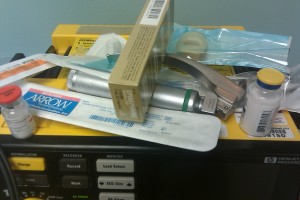
PHARMA, OH – A lone tear splashed to the floor, followed by a steady trickle as the residents tried to console the sobbing medical students. “We saved his life,” whimpered one snot-faced student. “By the end of the hour-long code, he had an occasional heart beat and everything.”
Our reporters found another devoted student crouched by the continuous dialysis machine in the medical ICU, stroking its curved sides lovingly. “Are we sure they’re really dead? Maybe we can just hook them up to this beautiful CVVHD machine to increase their quality of life.”

As usual when they needed comfort from a distant and twisted substitute for a father figure, the students turned to critical care anesthesiologist Dr. Troche. Dr. Troche began a heartwarming lecture with the assembled medical students by pointing out that the potential cost savings of avoiding needless care to the community would be even greater than last year’s switch from Lift for Life trauma helicopters to horse jockeys. The ICU nursing staff helped Dr. Troche break the news gently that all patients will die one day.
They passed out 4×4 gauze pads (tissues are on back order) so the medical students could wipe their tears away and blow their noses somewhere cleaner than the sleeves of their lab coats. The nurses even changed the channel on the lounge TV to show the medical students The Lion King and explain the cycle of life. As Dr. Troche affirmed that long-term transcutaneous pacing was not an acceptable part of palliative care, multiple code blue alarms suddenly rang overhead – apparently the med students weren’t the only ones watching The Lion King.
When it was all over, the census and patient acuity level in the ICU had decreased to levels not seen since the nurse float pool was drained. Reportedly, Dr. Troche is considering taking his lecture on a national tour of medical schools. Well, actually, a regional tour—a corporate jet or bus for the tour isn’t in the budget, and the Lift for Life horse can only gallop so fast.
Charlotte’s Web might have been a good movie to show too, but (spoiler alert) we wouldn’t want residents to think that baby spiders are a good outcome.
I don’t want to see people die. But I also know death is inevitable. Let people go. It’s ok.
Thank you. As an er nurse I’m happy to see a resident call time of death. When they are on hospice and they were in PEA before arrival it’s OK to let go.
hysterical. and i have lots of story ideas for you!